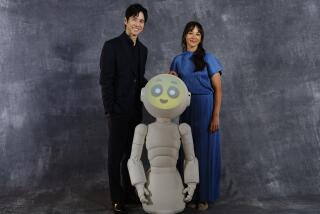Has Technology Gone to the Dogs?
- Share via
High-tech pundit and futurist Paul Saffo of the Institute for the Future in Menlo Park, Calif., has said, “If you want to see the future of technology, look under the Christmas tree.”
Saffo means that one can now find some of the most advanced technology in children’s toys. The Sony PlayStation 2, for example, the company’s new sold-out video game player, displays spectacular state-of-the-art graphics. Nintendo’s popular Game Boy pioneered color screens and instant photos on hand-held computers.
What’s under the tree this year? One of the more popular toys seems to be some breed of robot dog. Sega is offering the Poo-Chi and the Super Poo-Chi, about $30 to $60. Manley Toys, a U.S. company, is selling the silver Tekno the Robot Puppy for $40. Fisher-Price has Rocket the Wonder Dog for $130, and Trendmasters makes Big & Lil’ Scratch Interactive Dogs, two mechanical dogs, for $60.
But the big dog of the pack is Sony’s Aibo ERS-210 (not a very doggy name), which probably won’t be under many Christmas trees because it costs nearly $1,600. Aibo is in a class by itself--best in show so to speak--because of its allegedly intelligent behavior. Sony calls it its “second generation autonomous robot companion,” a phrase that’s a clunky fusion of science fiction, Japanese science policy and military robotics lingo.
The Sony robot dog series has been wildly popular. The first generation consisted of 5,000 copies of the ERS-110 model, at $2,500 each, and all of them sold out within days. An update to that model, the ERS-111, sold out 10,000 copies in November.
As a dog lover--I have two, each one the least robot-like dog imaginable--I’ve been curious about Aibo, if only for curiosity’s sake. One of the more curious things about Aibo is Sony’s marketing hype for the product, which is familiar to anyone who has followed some of the technology field’s more outlandish claims about robotics and artificial intelligence.
“Aibo” means “companion” in Japanese, and Sony apparently is not using this term frivolously or tongue in cheek. “Aibo is not a toy!” stresses the Aibo Web site (https://www.us.aibo.com). Aibo is “a true companion with real emotions and instincts. With loving attention from its master, it can even develop into a more mature and fun-loving friend as time passes,” the Web site says.
“In short, Aibo is a friend for life,” Sony claims. They must have seen that poster in my vet’s office that says, “Dogs Are for Life, Not Just for Christmas.” One wonders what Aibo’s life span really is--especially for the ERS-111 model, now outclassed by ERS-210.
Sony has gone way over the top in its enthusiasm for its Aibo. “Aibo actually has emotions and instincts programmed into its brain. Aibo acts to fulfill the desires created by its instincts. If satisfied, Aibo’s joy level will rise. If not, then it will get sad or angry. Like any living being, Aibo learns how to get what it wants.” That last part is a bit ominous, although not unknown behavior among dogs.
Robert Jastrow, an astrophysicist and former director of the Goddard Institute for Space Studies, wrote in Science Digest in 1982: “In five or six years--by 1988 or thereabouts--portable, quasi-human brains, made of silicon or gallium arsenide, will be commonplace. They will be an intelligent electronic race, working as partners with the human race. We will carry these small creatures around with us everywhere. Just pick them up, tuck them under your arm and go off to attend your business. They will be Artoo-Detoos without wheels: brilliant but nice personalities, never sarcastic, always giving you a straight answer--little electronic friends that can solve all your problems.”
Jastrow’s prediction was obviously off by many years, but he would no doubt be encouraged by the appearance of Aibo ERS-210. Other researchers, such as Hans Moravec of Carnegie Mellon University and inventor and author Ray Kurzweil, have argued that robots with intelligence superior to human beings are only a matter of time. Earlier this year, Bill Joy, chief scientist of Sun Microsystems, warned of a future populated with super-smart robots in a widely read and discussed essay in Wired magazine.
The person who coined the term “robot”--Czech playwright Karel Capek, who introduced the word (it means “serf” or “forced laborer” in Czech) in his 1921 play “R.U.R.”--had another opinion.
Writing about himself in the third person in 1935, he said, “It is with horror, frankly, that he rejects all responsibility for the idea that metal contraptions could ever replace human beings, and that by means of wires they could awaken something like life, love or rebellion. He would deem this dark prospect to be either an overestimation of machines, or a grave offense against life.”
Simulating the behavior of dogs would appear to be a manageable task, because dogs often seem programmed by their instincts. It may be easier than we think to fool people into thinking they have indeed purchased an automated “best friend.” Somehow that prospect seems sad and disturbing, like Jastrow’s rosy but unwittingly pathetic prediction.
Is the future of technology one in which we’ll be able to substitute a mechanical dog for that age-old Christmas-morning portrait of the child gazing adoringly at his new puppy?
At a time of the year when we’re surrounded by quaint and cheerful fantasies, it may be time to stop and separate marketing hype and adolescent-like fantasy from real life, in all the senses of that essential phrase.
*
Gary Chapman is director of the 21st Century Project at the University of Texas at Austin. He can be reached at gary.chapman@mail.utexas.edu.
Connect
Check out other Digital Nation columns at www.latimes.com/dnation






